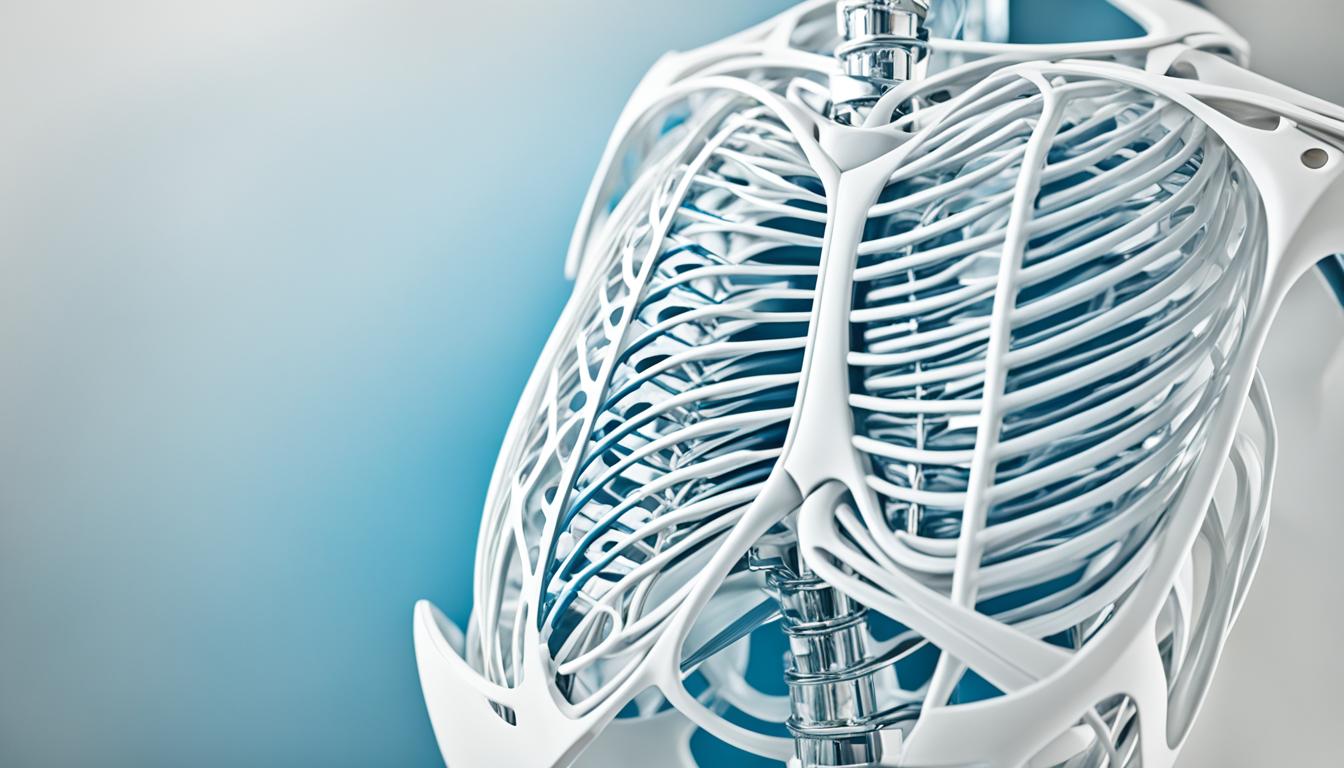Funnel chest is a chest deformity known as pectus excavatum. It causes a sunken area in the breastbone, usually the lower part. This can press against the heart and lungs. It leads to trouble breathing, chest pain, and a decrease in how much air the lungs can hold. The condition usually gets more noticeable during the teenage years.
Key Takeaways:
- Funnel chest, or pectus excavatum, is a congenital chest wall deformity.
- Symptoms of funnel chest include shortness of breath, chest pain, and restricted lung capacity.
- The condition can be diagnosed through physical examination and imaging tests.
- Minimally invasive surgeries, such as Nuss surgery and Ravitch surgery, are common treatment options.
- Stem cell therapy shows promise in treating funnel chest and promoting tissue regeneration.
Types of Chest Wall Deformities
There’s more than funnel chest when talking about chest wall issues. Others are:
- Pectus carinatum (or pigeon chest) – the sternum sticks out because of odd rib-to-sternum bones growth.
- Jeune syndrome – a type of dwarfism where the chest looks like a small bell. This happens because the ribs don’t grow right and the chest cavity stays small.
- Poland syndrome – causes a mix of irregularities on one side of the chest. This can mean missing chest muscles, different ribs, and an arm or hand that didn’t grow fully on the same side.
- Primary rib anomalies – these can create various chest wall issues. Some people might have too many ribs, some might be stuck together, others might not be fully developed.
Treatment Options for Chest Wall Deformities
How we treat chest wall issues depends on how serious they are. For small problems, doctors might suggest physical therapy. This can help make your posture better and widen your chest. But, big problems usually need surgery.
Surgeries like Nuss and Ravitch surgeries fix chest wall issues by moving the sternum and ribs back where they need to be. These surgeries heal faster and leave smaller scars than older types of operations.
Using stem cells to treat these conditions has become more popular lately. Stem cells can help make new tissue and repair the chest, which might mean less need for surgery.
If you have a chest wall deformity, it’s key to see a doctor who knows a lot about chest issues. This expert can help figure out the best treatment for you.
Treatment Options for Chest Wall Deformities
Chest wall deformities can range from mild to severe. Mild cases may get better with physical therapy and exercises. These help with posture and chest expansion, without needing surgery.
For more serious cases, surgery is likely the best treatment. Nuss surgery and Ravitch surgery are the main options used to fix chest wall issues.
Nuss surgery is done with small cuts and a curved steel bar under the sternum. It reshapes the chest and has a quick recovery time. The steel bar is taken out after two to three years.
Ravitch surgery, however, is more invasive. It involves a bigger cut on the chest. It’s used for complex cases or when Nuss surgery won’t work. It allows for more custom fixes for chest issues, such as removing bad cartilage or changing ribs.
Surgery is usually effective, but there’s also interest in using stem cell therapy. Stem cells can turn into different types of cells. This could help the chest wall heal naturally, promoting tissue repair.
FAQ
Q: What is funnel chest, and what are its symptoms?
A: Funnel chest is a condition where the chest looks sunken in. It’s also called pectus excavatum. It can lead to shortness of breath, chest pain, and make it hard to breathe fully.
Q: What causes funnel chest?
A: It’s a condition some people are born with. Doctors don’t know the exact cause. But they think it might be because the part that connects the ribs to the breastbone grows too much.
Q: How is funnel chest diagnosed?
A: Doctors can find funnel chest through a check-up and by asking about your health. They might also use X-rays or CT scans to see the chest.
Q: What are the treatment options for funnel chest?
A: How to treat funnel chest depends on how bad it is. Simple exercises can help some people. But surgery to fix the chest shape is usually needed for more serious cases.
Q: Are there other types of chest wall deformities?
A: Yes, there are several other types of chest wall deformities. Some examples are pectus carinatum (pigeon chest), Jeune syndrome, Poland syndrome, and primary rib anomalies.
Q: What are the treatment options for chest wall deformities?
A: The right treatment for chest wall problems changes with each person’s case. Surgeries like Nuss or Ravitch are often used. Sometimes, doctors might suggest stem cell therapy.

